Migration part of global development
In September 2000, the United Nations Millennium Development Goals rallied the international community behind a shared vision. The MDGs, which expire in 2015, signaled a new era of global cooperation. They triggered real progress in terms of lifting millions of people out of extreme poverty, improving health and access to education, and empowering women.
The eight original MDGs, which include reducing child mortality and achieving universal primary education, are lauded for their simplicity and measurability. They took an abstract, outsize challenge and distilled it into achievable ends. But as Albert Einstein loved to say, "Not everything that counts can be counted, and not everything that can be counted counts."
Today, it is important that we do not become trapped by what worked in the past. To succeed, the post-2015 agenda must break the original mold. It must be grounded in a fuller narrative about how development occurs - a narrative that must account for complex issues such as migration - otherwise the global development agenda could lose its relevance and thus its grip on stakeholders.
It is perhaps understandable that the original MDGs did not mention either internal or international migration. These are politically sensitive topics that could have polarized, rather than united, the international community. Moreover, our empirical understanding of how migration interacts with development was limited at the time; there was little data with which to shape measurable goals.
Yet migration is the original strategy for people seeking to escape poverty, mitigate risk and build a better life. It has been with us since the dawn of mankind, and its economic impact today is massive. Migrant remittances exceed the value of all overseas development aid combined, to say nothing of the taxes that migrants pay, the investments they make and the trade they stimulate.
As we consider the next-generation development agenda, it is also critical to understand that migration was a vital force in achieving the original MDGs. There are an estimated 215 million international migrants today - a number expected to grow to 400 million by 2040 - and another 740 million internal migrants who have moved from rural to urban areas within countries. Each typically supports many family members back home, which also helps to lift entire communities.
In Bangladesh, for example, just 13 percent of households that receive remittances from abroad are below the poverty line, compared to 34 percent of non-remittance-receiving households. Evidence from Latin America, Africa, South Asia and elsewhere shows that remittances reduce the depth and severity of poverty, and that the additional income is disproportionately spent on education and health. In rural Pakistan, remittances are associated with higher school enrollment, especially for girls. The list goes on.
- China to take new measures to fight poverty for MDGs: Wen
- MDGs summit axis for reaching goals at target date
- UN chief sees MDGs achievable, calls for efforts
- China submits proposals to achieve MDGs target
- More Chinese to migrate, invest overseas: report
- Migration pull and push factors
- Migration devastation





















